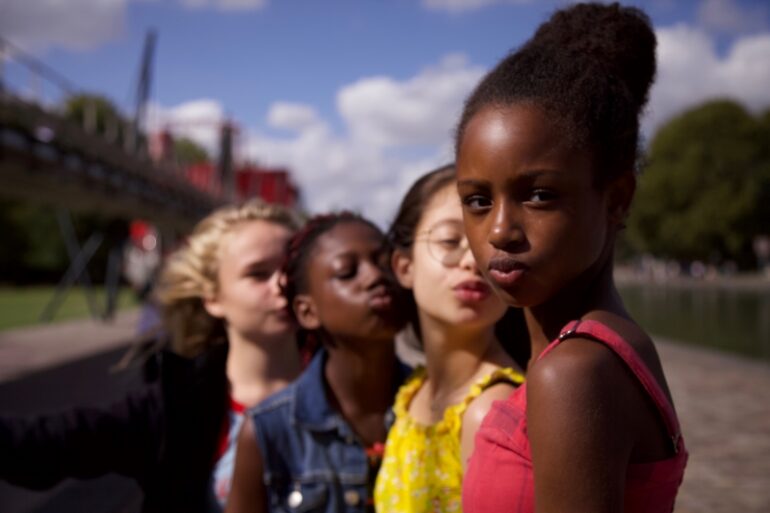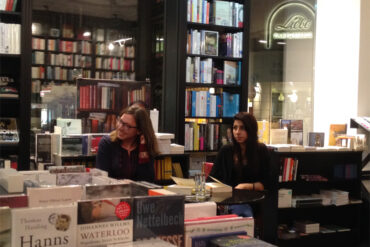As it was released by Netflix, Cuties became the center of an online debate because of the poster Netflix used to advertise it. Exploring the heated debate as well as the movie’s mise-en-scène and cinematography is key to unveiling whether the movie is really problematic.
By Abdelbari Saoufi
Picture: © MIGNONNES de Maïmouna Doucouré par Jean-Michel Papazian pour BIEN OU BIEN PRODUCTIONS
Cuties is directed by the Franco-Senegalese director MaïmounaDoucouré and was released by Netflix in August 2020. Upon its release, the film has been met with fierce criticism for its sexualization of pre-teen girls. This is because of the image that Netflix used as an ad of the movie. The artwork presented four pre-teen girls posing sexually in elastic pants and crop tops, which caused #cancelNetflix to go viral on social media. After the outrage had erupted, Netflix told BBC News: »This was not an accurate representation of the film so the image and description has been updated«.
Then, it went on to apologize in a tweet: »We’re deeply sorry for the inappropriate artwork that we used for Mignonnes/Cuties. It was not OK, nor was it representative of this French film which won an award at Sundance. We’ve now updated the pictures and description«. Many opponents of the film, including those who had not even watched it, organized a petition to cancel Netflix claiming that it »sexualizes an 11-year-old for the viewing pleasure of pedophiles«. On the other hand, Doucouré explained that she portrayed this kind of oversexualization of underage girls in her movie to rather condemn it.
Cuties (Orig.: Mignonnes)
France 2020
96 minutes
Director: Maïmouna Doucouré
Starring: Fathia Youssouf, Médina El Aidi-Azouni, Esther Gohourou, and others
The film is about an 11-year-old French-Senegalese girl who is growing up and attending school in Paris. Her family’s culture is very different from the one she is experiencing in France. Amy feels lost between her family’s conservative culture and the French liberal culture. She is driven to desperation and feels lonely especially after she learns that her father is marrying a second woman. This polygamous marriage hurts her mother’s feelings and makes her life miserable. Being fed up with her family’s conventions, Amy meets a dance group of girls (Cuties) in her school. She becomes fascinated with their dance routine, and decides to join them.
A Fierce Debate
The film’s accusers attacked the movie for portraying what they called »unwatchable« dance routines performed by the young girls, and claimed that it was a case of pornification and sexualization of under-age girls. Moreover, Right-wing activists were among the first to boycott Netflix and demand its cancellation. Ted Cruz, a republican senator, demanded that the justice department must carry out an investigation into the allegations against Netflix. Furthermore, other far right groups such as CitizenGo in Madrid also called for boycotting and cancelling Netflix as this petition swiped all the way to France, Italy, and Germany accusing Netflix of »child pornography«. The Rolling Stone subsequently wrote that the film »fuels the far right obsession with pedophilia«.
Although there is a number of opponents claiming that this movie is in many ways obscene, there are also those who support it for its educational quality. The film was defended by the French culture minister, who said that the attack on Netflix was based on a wrong interpretation of the film. The Italian bishops’ newspaper also contended that »when interpreted correctly and presented well, it can become an educational film«. The latter might refer, for example, to the dance scene, where the Cuties perform their final dance in the competition. Here, it is made quite clear that the film tackles the sexualization of pre-teen girls critically. It portrays how disgusted the audience is when watching the Cuties’ dance routine. One shot of the scene displays one audience member trying to cover her child’s eyes to prevent her from seeing the performance on the stage. Nevertheless, in alerting parents to the impact of social media on their children, Doucouré might have gone too far to make her point and convey her message. In doing so, she breaks with established moral conventions, as editor Dan Hitchens puts it in a tweet:
There are some things our eyes simply shouldn’t see, even if we come to the right conclusions about them. It’s just wrong, for instance, to install hidden cameras in your neighbour’s house, even if your ultimate goal is to issue a searching critique of surveillance capitalism. Additionally, even if we accept that the intent of the film was benign, the actresses performing in it – young girls – had to be coached and instructed to perform the obscene dance moves and speak the explicit dialogue.
Doucouré might not have intended to cater to the male gaze as she was among those who disagreed with the advertising campaign of Netflix. After all, as a female director, she probably would not want her female character to be objectified. But in trying to shock adult viewers with the perilous nature of social media on children, she inevitably had to appeal to the male gaze through the oversexualization of her pre-teen characters. Examining the film’s mise-en-scène, cinematography, and Laura Mulvey’s concept of the male gaze assists in revealing to what extent the movie can be considered problematic.
Mise-en-scène and Cinematography
One of the most significant scenes in the film that leave the audience uncomfortable is the one that starts in the Laundromat, where Amy wants to show Angelica that she can dance like the Cuties. Angelica likes the way Amy dances and tells her that she does not know if the other girls would accept Amy as a member of the Cuties. Then, Amy starts another type of dance to show Angelica that she knows a type unfamiliar to the dance group. Amy starts twerking and performing fetishized dance moves, which she has previously seen in video clips. The scene cuts into their rehearsal place under the bridge where Amy teaches the Cuties this kind of dance. Here, there are a number of close-ups and medium close-ups that mainly focus on the young girls’ lower bodies as they move through different sexual poses. In addition, the music contributes heavily to the pornification of the scene because the song is about sexual intercourse. Thus, all the cinematic tools used in this scene from sound to camera angles do sexualize the under-age girls.
Another scene that is of great importance is the one where the girls dance on the stairs. In this naturalistic mise-en-scène, the young girls are dressed in adult-like tight clothes that expose their female bodily features, and wear lipstick that matches their clothing. The scene starts with a low camera angle and cuts back and forth between close-ups and medium close-ups while the camera moves in different directions to include all of the young girls dancing. The medium close-ups film the sexual poses made by the girls’ facial expressions including putting their fingers in their mouths. On the other hand, the close-ups demonstrate the sexualized dance moves, zooming in closely on the girls’ lower and upper body parts.
The Male Spectatorship Gaze and its Pedophilic Connotations
Laura Mulvey has used psychoanalytic theory to investigate socophilia1Scopophilia: »Mulvey refers to scopophilia as the pleasure involved in looking at other people’s bodies as (particularly, erotic) objects without being seen either by those on screen or by other members of the audience« (Oxford Reference) , and she argues that the female character is always placed by traditional narrative film as a passive object for the active gaze of the man. Applying Mulvey’s theory on Cuties might turn the conventional male gaze adopted by contemporary film making into a pedophilic male gaze since the object of the gaze is an underage female character. There is a scene in the movie that objectifies Amy and makes her an erotic object for the male gaze2The male gaze, according to Laura Mulvey, is the act of depicting women in the arts and literature from a heterosexual masculine perspective that represents them as sexual objects for the pleasure of the male viewer.. This scene starts when the Cuties are caught by the security guard, and the guard tries to get their parents’ phone numbers because they have sneaked into a laser-tag hall. When they refuse to give him the phone numbers of their parents, another security guard arrives. Before the security guards call the police, the Cuties inform them that they are dancers, and Amy starts twerking in front of them. Here, Amy is portrayed as an erotic object to the security guard’s male gaze whose look towards Amy’s twerking is filled with curiosity and fascination. In this scene, the film provides all the elements that make Mulvey’s male gaze possible.
Overall, Director Doucouré could have tackled the issue in a more subtle way and could have informed her audience in a more thoughtful manner. Despite not necessarily having bad intentions, some critics claim that Cuties is a child-exploitation movie. This is arguably true because the pre-teen actors are not old enough to decide whether they want to be sexualized or not. Nevertheless, it is remarkable that most of the criticism directed towards the movie came from right-wing activist groups. This calls into question their fierce unjustified attack on Netflix, especially since many of them had not even watched the film. It does not seem too far-fetched to think that this unrelenting wave of criticism for the far-right might also have something to do with the fact that director Decouré is a Black woman. This debate remains subject to a considerable degree of skepticism, and further investigation might prove fruitful to find out what is behind right-wing ideologies in this regard.






